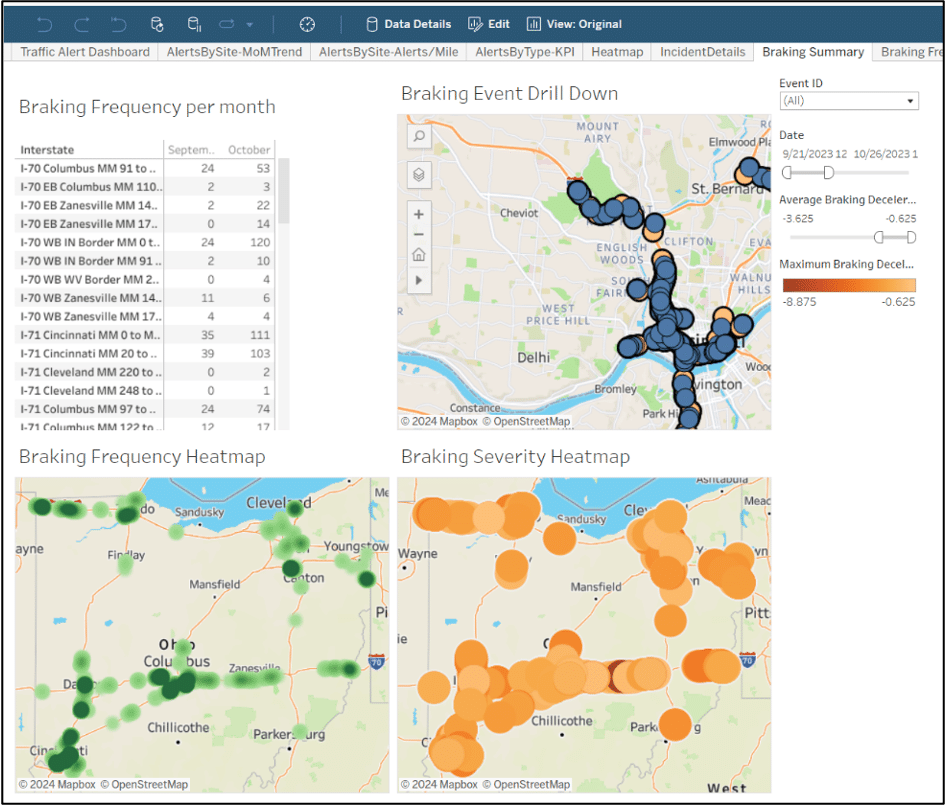
When transportation professionals propose or implement new technologies, measuring the impact is important. After millions of alerts delivered across thousands of interstate miles, the evidence is clear: in-cab safety alerts powered by INRIX data are working. They are changing driver behavior and that benefits drivers, fleets, and transportation agencies alike. The numbers tell a compelling story of potential crashes prevented, and millions of dollars in economic benefits realized.
Recent studies from leading research institutions have quantified what drivers have been experiencing firsthand. When professional truck drivers receive in-cab alerts, like the “Sudden Slowdown Ahead” alerts on their screens, they pay attention and drive safer. The data shows that advanced warning systems are positively influencing how commercial vehicles navigate hazardous conditions, with measurable improvements.
How the System Works
Before diving into the results, it’s important to understand the technology delivering these safety improvements. The Drivewyze Smart Roadways Alert system, powered by INRIX data, continuously monitors traffic conditions using real-time data from millions of vehicle probes. When dangerous slowdowns or unexpected congestion are detected, geo-targeted alerts are instantly delivered to approaching trucks through their Electronic Logging Devices (ELDs), providing 2-3 miles of advance warning.
This proactive approach addresses a critical physics problem: fully loaded commercial trucks require 66% more stopping distance than passenger vehicles. By providing earlier warning than traditional visual cues like brake lights, the system gives drivers more time to safely adjust their speed and avoid crashes.
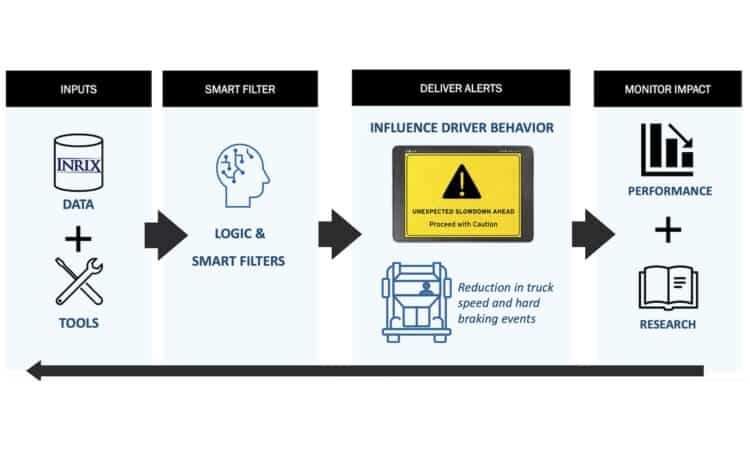
Quantifying the Improvements
Study 1: Purdue, Speed Reduction Analysis
Purdue University researchers analyzed driver responses across Ohio’s interstates, examining approximately 3,000 instances of trucks receiving alerts and over 800,000 truck waypoints during a 47-day period in Fall 2023. The study tracked individual vehicle trajectories from 60 seconds before receiving an alert to 5 minutes after.
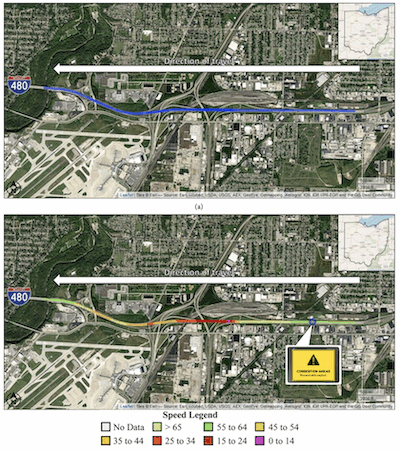
Key findings from this report include:
- 22% of all drivers receiving Dangerous Slowdown alerts reduced their speed by at least 5mph within 30 seconds of receiving the alert
- 26% of all drivers traveling at or above 70mph reduced their speeds when alerted
- Average speed reductions ranged from 7 to 11mph depending on conditions
- At any speed reduction threshold, over 60% of drivers reduced their speeds (even slightly) after receiving Dangerous Slowdown alerts.
The study also discovered different spatial distributions based on alert types:
- Congestion alerts were focused mostly in urban areas
- Dangerous Slowdown alerts were spread across the interstates, both rural and urban
Study 2: Cleveland State University, Secondary Crash Reduction
Cleveland State University conducted a full evaluation of the Ohio Department of Transportation’s partnership with Drivewyze. The study compared pre-implementation (2018-2019) and post-implementation (2022-2023) periods to assess the system’s impact on crashes and economic outcomes.
Key findings from this report include:
- 29% reduction in secondary crashes involving commercial vehicles
- $14 million in economic benefits saved by ODOT
- 5 hours of delay reduction per mile in the post-implementation period
- 56 benefit-cost ratio for reducing congestion-related crashes
- Reductions observed in all injury categories except serious injury cases
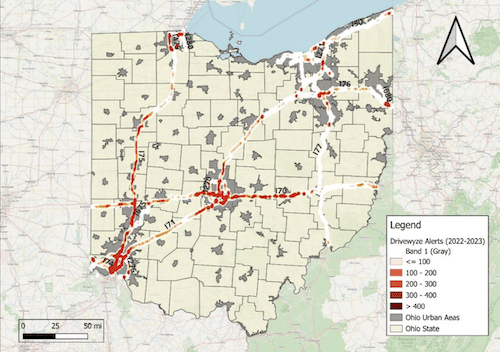
The research methodology included surveying 623 truck drivers at 15 rest areas across Ohio. Driver perception data revealed that 89% of drivers who received alerts felt that Sudden Slowdown alerts were effective, with 51% rating them as “very effective.” Similar positive results were found for Congestion alerts.
Study 3: Purdue, Hard Braking Analysis and Response Patterns
Purdue University’s Indiana DOT study analyzed approximately 20,000 alerts across 44 corridors from April to June 2024. The research analyzed footage from front-facing camera images to understand what drivers were seeing at key milestones, providing deeper insights into driver response patterns.
Key findings from this report include:
- 2% of trucks reduced speeds by at least 5 mph within 30 seconds of Dangerous Slowdown alerts
- 15% of trucks receiving Congestion alerts showed similar speed reductions
- 84% of trucks avoided hard braking throughout their entire trajectory after receiving alerts
- Only 16% of trucks recorded deceleration values exceeding the hard-braking threshold
The study documented an important behavioral phenomenon: “anticipatory braking.” Many drivers slowed down immediately after receiving an alert, even without visible congestion ahead. This shows trust in the alert system and increased attentiveness. Early responses prepared drivers for actual congestion 1-3 minutes later, resulting in smoother speed transitions and fewer hard-braking events. Simply put: drivers are clearly more attentive, and drive safer, after receiving these alerts.
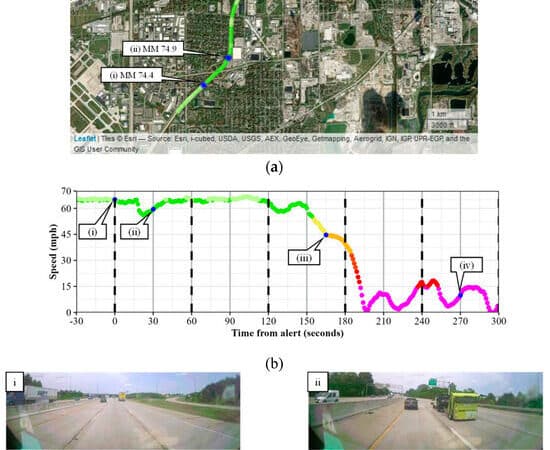
Long-term response patterns showed that the percentage of trucks reducing speed after Congestion alerts increased over time, reaching 80-85% within 5 minutes. For Dangerous Slowdown alerts, the percentage increased to about 55% by 2 minutes after the alert.
What the Benefits Mean for Transportation Agencies
State transportation agencies face pressure to improve highway safety while managing constrained budgets. The in-cab alert system offers compelling advantages for agencies seeking immediate, cost-effective safety improvements.
The Ohio DOT experience illustrates the transformative potential. With a benefit-cost ratio of 22.56, the agency saved $14 million through crash reductions while spending a fraction of that amount on system implementation. Unlike traditional infrastructure solutions requiring millions in capital expenditure and years of planning, agencies can activate effective programs across entire interstate networks within weeks.
Additionally, the system provides agencies with unprecedented visibility into commercial vehicle behavior and safety patterns. Transportation officials can monitor real-time analytics on alert locations, driver response rates, and changes in crash patterns over time. This data enables data-driven decision making for future safety investments and helps agencies understand which types of alerts prove most effective across different roadways and traffic patterns.
Fleet and Driver Benefits
While transportation agencies realize infrastructure-level benefits, individual fleets and drivers experience direct operational improvements. The economic impact for fleets includes reduced crash costs, lower insurance premiums as safety scores improve, decreased vehicle maintenance costs from reduced hard braking, and minimized cargo damage from smoother driving patterns. These benefits combine with improved delivery reliability and enhanced driver retention through reduced stress and improved safety conditions.
The driver feedback from the Ohio study is particularly insightful. Among the 623 truck drivers surveyed, 89% found the alerts effective, with many reporting reduced stress from sudden traffic encounters and improved situational awareness. As one driver noted, “Getting that alert before I see brake lights gives me time to prepare instead of panic.”
Fleet managers surveyed in the Cleveland State study reported that in-cab alerts were “effective tools for improving driver behavior” and had “significantly reduced at-fault crashes.” The alerts are free for fleets when sponsored by public agencies. And, the integration with existing ELDs means no additional hardware installation or driver training burden, allowing for easy adoption.
System Growth and Adoption
The rapid expansion of the in-cab alert system demonstrates strong market validation. According to Drivewyze’s 2024 data the program had:
- A 151% increase in monthly alerts delivered
- A 96% growth in unique trucks receiving alerts year-over-year
This growth reflects positive outcomes from early deployments encouraging broader adoption. As state agencies witness the results achieved in Ohio and Indiana, more are implementing their own programs. The cycle continues as more fleets experience safety benefits and share their success within the trucking community. The more states and fleets that join the program, the safer our roadways become.
Key Insights from the Research
The three research studies provide clear evidence of:
- Driver Behavior Modification: Between 15-26% of commercial drivers significantly reduce their speed after receiving in-cab alerts, with higher response rates for Dangerous Slowdown alerts compared to Congestion alerts.
- Safety Benefits: The 29% reduction in secondary crashes in Ohio demonstrates substantial safety improvements.
- Cost-Effectiveness: With a benefit-cost ratio of 22.56, in-cab alert systems represent a high-value investment for transportation agencies compared to traditional infrastructure solutions.
- Driver Acceptance: The 89% effectiveness rating from surveyed drivers indicates strong user acceptance that supports continued adoption and system expansion.
Looking Forward
While these results validate the in-cab alert concept, the technology continues to evolve. The established infrastructure provides a foundation for expanding beyond traffic alerts to include work zone notifications and other safety-critical information. The ongoing collection of driver behavior data enables agencies to monitor performance and continue to make improvements in alert parameters.
As the system expands to cover more interstate miles and reach additional drivers, each alert delivered represents potential tragedy avoided. The marriage of INRIX’s real-time traffic data with Drivewyze’s connected truck network is proving that technology can make highways safer through proactive, targeted communication.
The evidence from these research studies answers definitively: in-cab safety alerts work. They change driver behavior, prevent crashes, and deliver substantial economic benefits. For transportation agencies seeking immediate safety improvements and for fleets aiming to protect their drivers and bottom line—this proven technology offers a clear path forward.
Want to learn more about Drivewyze Smart Roadways Alerts?
Join our upcoming webinar, Traffic Slowdown Alerts: How In-Cab Alerts Are Helping Fleets and Agencies Improve Safety Outcomes, to get a detailed look at this solution.

What You’ll Learn
- How real-time alerts help reduce emergency braking and secondary collisions
- How INRIX data powers instant detection of sudden traffic slowdowns
- Key impact data from state deployments (e.g., Ohio DOT)
- What sets Drivewyze apart in scale, speed, and ease of deployment




